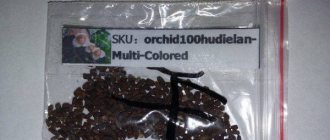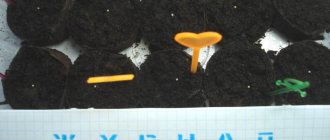Cuttings have long been considered the only and most effective way to propagate ornamental roses. Today, more and more gardeners prefer to experiment and prefer planting seeds. This is a long and labor-intensive process, but as a result the plant has increased resistance, immunity and an attractive appearance.
If you follow planting technology and proper care, you can grow a rose from seeds even at home. From the article you will learn all the intricacies of this method of reproduction.
Benefits of growing roses from seeds
Growing roses from seeds is a complex process that takes a lot of time and effort. It is possible to achieve flowering of the plant only after several years from the moment of planting. Despite this, this method has undeniable advantages:
- unlike cuttings, you can get several plants, which is especially important when landscaping the area, creating a flower bed or hedge on the site;
- roses grown from seeds are more resistant to disease and are stronger and more resilient plants;
- using seed propagation you can get a potted rose that can be grown indoors;
- the cost of seeds is significantly lower than rose cuttings, which makes it possible to save money when planting a large volume.
Planting material is difficult to find on sale, so flower growers often order seeds from China. However, the so-called Gift roses ordered from China do not always germinate, and the result of growing can be completely unpredictable.
You can also get the seeds yourself by collecting them after the adult plant has flowered, but they have low germination capacity and quickly deteriorate.
Advantages and disadvantages of the seed propagation method
Planting roses with seeds has its pros and cons. Let's denote them in Table 1:
| Advantages | Flaws |
| Availability and savings. This method is suitable if you need to get a lot of seedlings | The process is lengthy and labor-intensive, requiring certain knowledge and skills |
| Seedlings are resistant to weather changes and can quickly and easily recover from a harsh winter. | It is impossible to predict the external characteristics and features of a rose by seed. |
| The opportunity to find your own varietal type of rose and feel like a breeder | Not all varieties of roses are suitable for propagation using seeds. |
You should not hope that from the seed you will grow a rose identical to the mother plant or the photograph on the package. The genetic characteristics of distant ancestors may be preserved in the seed material, so planting seeds is an experiment with an unexpected result. You can get a copy only by propagating by cuttings.
When to sow seeds for seedlings
The timing of planting rose seeds depends on the climatic conditions in the growing region, as well as the type of plant itself. Choosing a period depending on the variety:
- Chinese roses are usually planted starting in early February. Usually they are highly resistant to unfavorable conditions, so seedlings can be replanted in early spring;
- It is recommended to sow polyanthus rose seeds from January, due to the slow rate of seedling development and the need for stratification;
- wrinkled and brown roses are usually planted as seedlings in the second half of autumn, followed by transplantation into open ground only in the spring.
In cold regions, you need to time planting to avoid frost during transplantation to a permanent location. To do this, the deadline is shifted by 1-2 weeks. If you plan to grow roses indoors, planting at any time of the year is acceptable.
Where and how can I buy seed material?
In order to avoid counterfeiting, it is better to buy plant seeds in official stores. You can buy flowers in stores such as Auchan, Leroy Merlin, Rose Apple, Lucky Garden, etc. - in Moscow, House of Seeds, Aelita Seeds, Phlox, Greenwood, etc. - in St. Petersburg. In addition, seeds can be purchased in an online store, where the price is much lower, but no one is responsible for the quality of the seeds.
The cost of seeds starts from 5 rubles and ends at 60 rubles for 10 pieces, the price depends on the type of rose.
Soil for sowing seeds
The substrate for germinating rose seeds should be light and fertile. It is best to use store-bought compositions intended for roses, but you can prepare the soil yourself. For this purpose, you need to mix garden soil, peat and sand in a ratio of 2:1:2.
The presence of drainage is a mandatory requirement, so you need to prepare expanded clay or pebbles in advance for subsequent placement on the bottom of the pot. If you use self-prepared soil, it must be disinfected before planting, for example, by calcining it or treating it with a 5% solution of potassium permanganate.
Preparation of seeds, soil and planting dates
The best germination is observed in slightly immature seeds, so they are collected when the fruits just acquire their red color. You need to take the fruit whole, without signs of rot or damage, cut it and take out the seeds; they may differ in color and size, but this does not at all indicate shortcomings. After extraction, the seeds are washed with a three percent solution of hydrogen peroxide. It is convenient to do this by placing them in a fine strainer, and placing it in a container with peroxide. This procedure will free the seed from residual pulp (which slows down germination) and will be an excellent prevention of fungal diseases. The procedure should be carried out for 15–20 minutes.
Washed seeds can be sown directly into the ground in the fall, or sown in the spring. Or you can grow seedlings at home, and then plant them when warm spring weather sets in. But for good germination, the seed must undergo stratification. When sowing in autumn, nature will create all the conditions for this; in all other cases, the conditions must be created artificially using a refrigerator. The seeds are placed between two cotton pads (or pieces of gauze folded several times), generously moistened with the same hydrogen peroxide, put it all in a tightly closed tray or plastic bag, which is left on the bottom shelf of the refrigerator for 2 months. You can put it in a cellar, basement, unheated storage room, the main thing is that the air temperature is maintained between +2 and +5 degrees. Seeds need to be periodically ventilated, remove moldy ones if any are found, and moisten the cotton wool or cloth. If mold begins to appear on the seeds, they need to be washed again with peroxide, it is better to moisten the cotton wool. It is recommended to soak seeds purchased in a store for several hours in a growth stimulator; stratification is required for them.
As soon as the sprouts hatch, the seeds are sown in the ground. The best soil is sandy-peaty; the seeds are lightly pressed into it with your finger and sprinkled with a thin layer of sand. Small pots and plastic cups are perfect for growing seedlings; it is convenient to use peat cups. As soon as the seedlings appear, the soil is mulched with a thin layer of perlite; this should protect the seedlings from blackleg.
For germination, the optimal temperature is +18 degrees, when young sprouts grow and gain strength, they will be comfortable at a slightly higher temperature, it is better that it does not rise above +22 degrees. They need to be placed in a bright place, shaded from strong sun, but the daylight hours should be extended to 10 hours. Water the seedlings moderately, just not allowing the soil to dry out.
The soil should be light, fertile and non-acidic. Roses do best in humus-rich loam. Heavy soil should be mixed with peat and sand; it would be good to add compost or humus. Acidic soil is corrected by adding lime or dolomite flour. Before planting seedlings, the area is dug well to a depth of 30–40 cm, at the same time you can improve the soil - add compost or humus, superphosphate, potassium sulfate.
How to prepare seeds before planting
Stratification is a mandatory step in growing roses from seeds. For this purpose, planting material is carefully sorted and all damaged and deformed specimens are removed. After this, the seeds need to be treated with a 10% solution of hydrogen peroxide or a 5% solution of potassium permanganate. When working with purchased polyanthus or Chinese roses, there is no need to trawl the seeds, since this has already been done by the manufacturer.
Then the seeds are laid out on a cotton pad soaked in hydrogen peroxide and covered with another one on top. They are placed in plastic bags, on which it is convenient to attach a sticker with the name of the variety, and then put in the refrigerator. In such conditions, the seeds should be kept for 1.5-2 months at a temperature of +2-5°C. During this time, you need to regularly check the substrate for mold and moisten it as necessary. After the sprouts appear, the planting material is ready for sowing.
Preparatory work
Before you start planting roses, you need to monitor the quality of the seed, which:
- can be bought or ordered in a store specializing in the sale of everything necessary for growing garden and home plants;
- collect it yourself from the rose bushes you like.
From seeds purchased ready-made, small shoots are often obtained and roses have small buds. Self-collected and properly processed planting material produces larger pink flowers. In order to collect them yourself, you need:
- so that the fruits on the bush turn red (on average, from the end of June);
- pick beautiful, whole fruits, excluding dried and rotten ones that cannot be used for sowing;
- cut each fruit and remove all the seeds from it, clearing them of pulp;
- high-quality seeds are pale red in color and appear unripe. It is worth noting that one box may contain seeds of different shapes, but this does not affect their quality.
Important! Seeds from unripe fruits germinate more easily and have a more powerful germination and growth force, so they are collected before the beginning of autumn, before their final ripening is complete.
Preparing the container and soil for planting
To plant rose bush seeds, you need to take care of high-quality soil. For this you can use:
- special universal substrate for seedlings, sold in a flower shop;
- prepare the planting mixture with your own hands.
A homemade substrate should contain:
- turf or garden soil;
- coarse sand;
- lowland peat.
This sandy loam soil should have a neutral pH of 6.5. Check out the basic ways to grow roses from cuttings at home.
It is convenient to plant rose seeds:
- into cassettes;
- peat tablets;
- landing boxes.
They avoid the need for picking and make it possible to replant ungerminated seeds.
Seed treatment
Preparation of planting material involves the following manipulations:
- In order to preserve the seeds and prevent them from rotting, immediately after removing the fruit from the fruit pod, they are washed, placed in gauze or a sieve, and immersed in a solution of hydrogen peroxide for 20–30 minutes. This procedure will disinfect the planting material and prevent the appearance of mold.
- After this time, a substrate soaked in peroxide solution is formed for them. To do this, 2 parts of a paper towel, cloth or cotton pad are moistened in the specified liquid and seeds are laid between them.
- For further conservation, planting material is laid out in separate bags along with the substrate. The bag must close well to prevent rapid evaporation of the liquid.
Important! The package with seeds must be marked, indicating the date of collection of planting material, the beginning of its stratification and the variety of rose bush. To speed up germination, the substrate is sent to the refrigerator, immersing the bags in the compartment, at a temperature not exceeding +5°C
This will allow us to carry out the stratification procedure - simulating natural conditions in winter in the natural habitat
To speed up germination, the substrate is sent to the refrigerator, immersing the bags in the compartment, at a temperature not exceeding +5°C. This will allow the stratification procedure to be carried out - simulating natural conditions in winter in the natural habitat.
This treatment lasts 2 months. The condition of the seed substrate should be checked regularly to exclude the possibility of mold. If traces of it are found, it is necessary to rinse the contents of the bag and place it in a new, impregnated substrate. It is also necessary to ventilate the substrate and additionally moisten it if the moisture has evaporated.
However, this is not the only method of stratification that can affect the rate of emergence of rose bush seedlings. A longer option involves preparing seeds for 8 months. After receiving the seeds, they are mixed with wet sand and placed in containers, boxes can be used for this, and sent to the basement. The air temperature in this room should be +3…+5°C. The seeds must be kept in the given temperature conditions and moistened sand for the entire specified period. Ventilation in the room should also be controlled.
Popular articles When do boletus mushrooms grow and where do they appear in the Moscow region?
What you need to grow a rose seedling
In order to grow a rose at home you will need:
- seeds;
- general container and individual pots for seedlings or peat tablets;
- hydrogen peroxide;
- cotton pads;
- purchased or prepared substrate;
- expanded clay, pebbles or coarse river sand.
The agricultural technology for growing roses from seeds is practically no different from other plants, so a standard set of equipment and items is usually required.
How to grow
How to grow roses from seeds from Aliexpress? Many users complain that growing roses from Chinese seeds is mostly not successful. Statistics confirm that this is indeed the case. There are several reasons for this.
- The conditions for keeping plants in China and Russia are different. Temperature, lighting and even the type of soil are of great importance for seeds that are preparing to germinate.
- The quality of seed material is difficult to control. Even purchasing from well-known Chinese sites does not guarantee success. The only way out in this situation is to read reviews and look at the ratings of specific sellers. If the information is positive, you can order seeds.
Yet despite this, people buy Chinese seeds and grow them successfully. We will tell you how to achieve good germination and flowering of roses from China.
Growing a rose from a cutting from a bouquet is a great way to get a beautiful flower for free.
Seed preparation
How to grow a rose from a seed? To do this, you must first prepare the seed well for germination. How it's done? Some people advise placing the seeds in the refrigerator for several days. This will simulate the winter season, after which the seeds will more actively “wake up” and hatch. Just remember not to put them in the freezer. It's better to put them at the very bottom of the refrigerator. A section intended for vegetables is a good choice.
After this, the seeds must be disinfected and soaked. To do this you will need:
Cotton pads can be replaced with gauze or even a piece of regular rag. The material must be thoroughly moistened with peroxide and the seeds placed on it. The environment for them should be sufficiently moist. The top is covered with another piece of cloth soaked in peroxide. After this, the plate with the seeds must be placed in a dark place where the air temperature is moderate (about 18 degrees). There they will stand until sprouts appear on them.
Photo from the site: www.supersadovnik.ru
Don't forget to sort out the seeds from time to time. Moldy seeds should be removed immediately. They still won’t germinate, and the mold can spread to neighboring seeds. Don't forget to ventilate the room.
Germination time can reach two months
It is especially worth paying attention to seeds from China. They could have been outside the plant for a long time and dried out greatly.
Without your help it will be difficult for them to germinate. It is for such purchased seeds that you can use a growth stimulator instead of peroxide. You will find a large selection of them in flower shops.
Landing
After sprouts have appeared on the seeds, they need to be planted. To do this you will need a pot, peat mixture or peat tablets
Sprouted seeds should be planted carefully, because roses are very delicate. It is worth noting that peat tablets are very convenient
By planting flowers in them, you can replant without disturbing the root system of the plant.
Seedling care
Rose seedlings require careful care. It must be watered moderately so that the soil is neither dry nor too wet. Sprouts react very quickly to dryness, as well as to excessive humidity. It is very easy to upset the natural balance and ruin delicate roses.
The air temperature for rose seedlings should be between 18-20 degrees. You also need a lot of light. It is advisable that access to it be at least 10 hours a day. If you planted roses in winter, then daylight hours can be artificially extended.
Don't forget to pick off the first rose buds. If they appear while the plant is still in the pot, then they take too much vitality. The rose may wither or even die. It is better to let it grow and enter flowering when full of strength.
Planting in open ground
When the rose seedlings grow a little, they can be transplanted outside into open ground. This should be done in the spring, when the weather is already warming up. If you plant your plants in the fall, you will not be confident that they will survive until spring. Therefore, it is better to wait until April-May.
Do not plant roses too abruptly. First, take flowerpots with plants outside for a short time. Then extend your time outdoors. Only after the roses have become accustomed to outdoor conditions, begin replanting into the ground.
Think about ways to improve your soil. It should be sandy-clayey, light. If it does not fit these parameters, then the area allocated for roses can be improved independently. To do this, add sand, peat or chalk to the dug soil.
A place for planting rose seedlings must be chosen that is not shaded, but not too sunny. Try to ensure that the plant is not disturbed by drafts and winds. It is necessary to care for the flower in the same way as for an ordinary rose.
Sowing seeds
After preparing the soil and the first sprouts appearing on the seeds, the rose can be planted in containers. Planting material is sown only superficially, without deepening it into the ground, but in order to avoid the appearance of a black leg on top, it is recommended to cover them with a thin layer of fine sand or perlite. After this, the soil is moistened with a spray bottle and the container is covered with film or glass.
Preparation of cuttings
To grow roses from a bouquet, you need to select the right cuttings. This is the most important stage of preparation and should not be neglected. Flower growers often argue about which stems to take - fresh, on the day of purchase, or already standing and withered. Both cases have their own arguments and chances of success. In the first option, the cuttings are used immediately, in the second, the dried sections on the stems need to be trimmed and the cuttings placed in cold water for a couple of hours.
But by and large, the only thing that matters is what the stem looks like. It should be strong, healthy, without signs of decay and at the initial stage of lignification. Young flexible green shoots have not yet gained strength for growth. Completely brown hard ones germinate poorly and often rot.
Cuttings of roses from a bouquet are carried out only with a sharp instrument - a knife or pruning shears. A dull blade unnecessarily crushes and injures the plant.
It is also important to treat all tools and planting containers from bacteria. To do this, just pour boiling water on the equipment or wash it with soapy water.
Growing conditions
To achieve healthy and strong seedlings, it is very important to create favorable conditions for their development. This can be easily done at home, it is only important to follow simple rules.
Lighting and location
A box of seedlings or peat pots is best placed on the eastern or western windowsill of an apartment, where it is easiest to achieve long-term, diffused sunlight. When exposed to direct sunlight, especially at midday, the seedlings must be shaded.
Temperature
The optimal temperature for seedling formation is 18-21°C. This is easy to create in an apartment, so additional heating is usually not required. Sudden changes in temperature should not be allowed, and it is also not recommended to keep seedlings in colder conditions.
Air and humidity
During the entire period of seedling growth, it should be regularly sprayed, avoiding waterlogging of the soil. Roses react acutely to drafts, so drafts should not be allowed to appear during the entire period of development of young plants. During the active heating season, it is especially important to maintain air humidity, since radiators lead to the formation of a dry microclimate in the room.
Watering
Throughout the entire period of seedling development, it is necessary to check the soil moisture. Avoid overmoistening and drying out, as well as the formation of a dry crust on the surface. In order not to harm the fragile root system of young roses, it is recommended to use only a spray bottle. When kept in a dry room, you can additionally water the seedlings, carefully introducing warm water between the plants.
Possible problems and solutions
- The most important problem is the long process of seed germination. Not all gardeners have the patience and perseverance to wait for the shoots to appear, and then for the tender shoots to gradually turn into a young plant.
- Chinese seeds may contain weeds. You need to notice in time where the roses have grown and where the weeds are. All weeds must be removed so that they do not take away the strength of the rose seedlings.
- Not all Chinese varieties of roses can survive in our climate. There are often cases when seeds germinate, but the seedlings die before or after planting in the ground. Also, young plants may not survive the winter, despite good shelter. The more unusual and exotic the rose variety, the more whimsical it is and is unlikely to be able to adapt to our climate.
If this happens, don’t be upset; try purchasing seeds of simpler varieties of roses. You also need to purchase as many seeds as possible, especially since they are inexpensive. From a large number, shoots will probably emerge, and some of them will certainly survive and develop into an adult bush.
Caring for rose seedlings
After emergence of seedlings, the planting of seedlings can be thinned out by removing all weak and deformed plants. After this, you need to follow simple care rules in order to get healthy seedlings ready for planting in open ground.
Temperature
After the formation of several leaves on the seedlings, the air temperature can be slightly reduced to 15-18°C. This is enough to maintain the health of the seedlings and for their development. You cannot store a container with seedlings on the balcony, since there is a risk of sudden temperature changes, especially at night, to which young plants always react sharply.
Backlight
For the harmonious growth of roses from seeds, daylight must be at least 10 hours. In early spring, this is usually not a problem in most regions, but when daylight hours decrease, additional lighting must be used. For this purpose, a phytolamp or a regular fluorescent lamp is best suited. The lamp should not be lowered low to the seedlings to avoid burns to the leaves.
Watering seedlings
Roses should be watered in such a way that the soil is constantly moist, but not too soggy. The substrate should not be allowed to dry out, which can lead to diseases of the root system. The optimal watering regime is 2 times a week when growing seedlings indoors. If necessary, for example, in case of wilting of leaves, you need to additionally spray the plants.
Feeding seedlings
During the growing period of seedlings, fertilizing is carried out twice. For this purpose, it is best to use liquid fertilizers for roses, which contain all the necessary beneficial elements and minerals. The first time the composition is applied after the first leaves appear, and then 2 weeks after picking. It is not recommended to use only nitrogen formulations, as this leads to rapid growth of the green parts, rather than the overall development of the plant.
Picking
When using peat pots, there is no need to pick. If you used a common container for seedlings, transplant the roses into individual containers when the plants have 3-5 strong leaves.
To do this, you need to carefully dig up the seedling and, together with a lump of earth, put it in a plastic pot filled with soil 2/3 of the volume. Then you need to add the substrate and water the plant generously. After transplantation, you should not use fertilizer for 10-12 days, allowing the rose to adapt to the new conditions.
Pinching
At the stage of growing seedlings, it is necessary to remove all deformed and damaged leaves. It is best to carefully pinch them rather than cut them with a knife. In addition, all seedlings affected by blackleg and other infections should be removed.
Diseases and pests of seedlings
The most dangerous diseases for rose seedlings are considered to be fungal infections, infection of which usually occurs when using poor-quality soil, non-compliance with temperature conditions and watering. Among the most common diseases, I highlight root rot and blackleg.
The infection can be determined by the characteristic blackening of the root part, which becomes viscous and loose. All affected seedlings must be removed, after which the substrate must be disinfected with a solution of potassium permanganate to avoid contamination of other roses.
The most common pest is the spider mite. Infection with it usually occurs when rose seedlings are grown in unsuitable conditions and care rules are not followed. The presence of an insect can be determined by the characteristic white-gray coating on the leaves and wilting of the green parts.
Most of the population can be destroyed mechanically, for example by washing leaves. And then you need to apply an insecticide, for example, Actellik, Aktara or Bordeaux mixture.
Transplantation to a permanent place
Planting in a permanent place is carried out only after the end of night frosts, which are destructive for young plants. In the middle zone, transplantation can be carried out from the second half of April; in the north it is recommended to wait until May. The seedlings need to be transplanted together with a lump of earth, into previously prepared individual holes.
The procedure is usually carried out on a dry and sunny day, and after picking the roses, you need to shade them and install a support to avoid damage from the wind. If you plan to grow a Chinese rose in a flowerpot or pot, then replanting can be done earlier, when keeping the plant on a balcony or loggia.
Regardless of the method of growing roses, the seedlings must be hardened before picking. After the formation of the first leaves, young plants should be regularly taken out into fresh air, gradually increasing the duration of the procedure to 4-6 hours. This allows you to strengthen the seedlings and reduce the risk of infectious diseases.
Planting seedlings in open ground
Before planting seedlings in open ground, as already mentioned, it is recommended to gradually accustom them to fresh air and place them outdoors under natural light. The hardening procedure begins at least 2 weeks before transplantation. As a rule, sprouts are planted in May. To do this, they dig holes or ditches, thoroughly loosening the fertile soil, and place future bushes in it.
Did you know? Rose bush flowers are a natural source of essential oil, recognized as one of the most expensive, since almost 500 kg of delicate petals must be collected to obtain 500 ml of the finished product. A popular variety for industrial production is the Kazanlak rose, in which the concentration of substances is as high as possible.
The place should be well lit and cozy, since roses do not like drafts. The soil for rose bushes should be clay with the addition of coarse sand. Lowland peat is added to it, which gives the substrate lightness and looseness, and fertilizer.
To improve soil quality use:
- dry mullein;
- mulch;
- purchased substrates;
- sapropel;
- tree bark;
- wood chips;
- pine sawdust.
Further care
The type and variety of rose determines its further care. It is important to consider that this is a moisture-loving and light-loving plant, the care of which is especially important in the first year of life. It is during this time that a powerful root system is formed, immunity and vitality are enhanced.
Watering
Water for the rose is applied only at the root to avoid moisture getting on the leaves, which can lead to the formation of spots on them. Throughout the summer, watering is carried out regularly up to 2 times a week at the rate of 10-12 liters of water per plant, if it is a dwarf rose, then up to 5 liters. To form young shoots, starting from the end of August, watering is completely stopped and resumed only in the spring at the beginning of the growing season.
Top dressing
Like other members of the Rosaceae family, the plant responds best to organic matter. That is why it is advisable to apply an aqueous solution of mullein or bird droppings twice a season - before the start of the growing season, and then during the transition to dormancy. Throughout the summer season, it is recommended to use liquid complex compositions for roses, which contain all the necessary macro- and microelements.
Loosening, mulching
The procedure is carried out in the first 2-3 years, until a natural layer of mulch from last year’s foliage is formed. Loosening should be carried out as a dry crust forms on the top layer of soil; the procedure is usually carried out 3-4 times during the summer. At the same time, it is recommended to add sawdust or peat to insulate the roots, reduce the growth rate of weeds and retain moisture on the surface.
Pinching, pinching, pruning
Shaping is an important task when caring for any type of rose. When growing these plants from seeds, during the first year, only pinch off deformed and weak leaves. And if flowering is observed, but all the buds must be removed, this will speed up the development of the plant itself and improve the quality of the flowers for the next season. Then the rose needs annual decorative and sanitary pruning, which is carried out in April.
Transfer
Roses can remain comfortably in one place for a long time without the need for replanting. Plant transfer is necessary when the growth rate has slowed down significantly and flowering is completely absent. Transplantation is carried out only in the fall, after first completely cutting off the entire bush to the base of the ground. A plant with several shoots and growth buds located on them is transferred to a new place along with a lump of earth, trying not to damage the developed root system.
Diseases and pests of roses
Like all cultivated plants grown in the garden, roses are susceptible to diseases and pest attacks.
The causes of diseases are:
- Poor illumination of the area.
- Thickening of plantings.
- Poor ventilation of the rose garden.
- Unfavorable climatic conditions.
- Increased soil acidity.
- Soil soaking.
- Lack of nutrients.
Not only special chemicals help to get rid of diseases, but also proper care of the crop. In some cases, the bushes will need to be transplanted to a new location, especially if the plants are planted in lowlands or in an area with stagnant water.
With high humidity, roses are affected by powdery mildew, which is considered one of the most common diseases of the “queen of flowers.” Most often, young leaves and shoots, as well as buds, on which a powdery white coating forms, suffer from the disease. Plants begin to weaken and wither, leaves curl and fall off, and inflorescences die. To combat the disease, it is necessary to get rid of the damaged parts and treat the plant with a solution of copper sulfate or colloidal sulfur.
Black spotting develops with high humidity and lack of potassium. Dark brown spots with dark edges form on the upper side of the leaf blade. The leaves begin to turn yellow and fall off. The affected parts should be cut off and the bushes treated with Bordeaux mixture, copper-soap solution or Fundazol.
The spider mite is an insect 0.5 mm long that weaves a web around the lower part of the leaf blade. Affected leaves begin to turn yellow and fall off. To get rid of the parasite, it is necessary to remove diseased leaves and treat the bushes with insecticides three times at intervals of 5–7 days.
Green rose aphids reproduce very quickly and form dense colonies on young shoots, leaves and buds. The parasite feeds on the sap of the plant, causing the bush to weaken and wither. To combat the pest, they are treated with Actellik, Fufafon or Aktara.
Proper plant care, including regular watering, fertilizing, loosening the soil, mulching and pruning, helps keep roses healthy and blooming profusely. Compliance with all agricultural practices reduces the risk of developing diseases and pests.
Adviсe
To get a healthy and strong plant, you can use the following useful tips:
- When purchasing roses on Chinese websites, carefully study reviews, photos and descriptions of planting material. It is advisable that the bag of seeds be accompanied by instructions;
- It is not advisable to start immediately with planting polyanthus roses. First, you can practice on Chinese seeds, which are easier to care for and easier to use;
- It should be remembered that the fruits of some varieties of roses must be collected before they ripen on the bush, otherwise they will be unsuitable for subsequent rooting;
- A rose grown from seeds can also be kept at home. To do this, you need to choose dwarf varieties or use a large pot;
- plants that were planted with seeds in the fall have time to form a stronger root system, which is useful for transplanting into open ground;
- The first flowering will most likely be absent or the buds will hardly develop. To improve the condition of flowers for the next season, they need to be pinched as they form.
Growing roses from seeds is a complex and time-consuming process, but the result is a beautiful and resilient plant. It can be grown at home or planted in your garden. Some Chinese roses have unusual petal colors that will become a real decoration for your garden.
Why do people order rose seeds from Chinese websites?
Websites selling seeds from China offer a huge range. In the catalog you can find not only roses in our usual colors, but also blue, purple, beige, black, brown and even light green. Many people cannot resist such variety and want to buy a lot of seeds at once.
It is difficult to judge how truthfully sellers describe their goods. Reviews are often contradictory. Many people note that there simply are no such colorful roses, and the seed sent either does not germinate or has nothing to do with exotic flowers. Others write that they received high-quality seeds from which the promised plants grew. Be that as it may, parcels with such contents almost always arrive. Even if the package contains not a blue rose, but an ordinary one, do not be upset. The main thing is that it grows and pleases you with its beauty and sweet aroma.
Another reason why people buy seeds from Chinese sites is that they are cheap. They cost just a penny, and in some cases they are also delivered for free. For little money you can buy seeds of a large number of plants here. Even if not everyone ascends, the losses will not be so noticeable. Even domestic seeds do not germinate one hundred percent.
Photo from the site: www.xa-xa.org
Purchase and transplant
It is better to purchase plants from trusted garden centers. This way you can be sure that the flower is not infected with dangerous pests.
When choosing, pay attention to the condition of the plant itself, and not to the number of buds. Often the bush is forced to bloom vigorously with special preparations.
After transplantation, such roses often die.
You should only buy healthy plants with dark green foliage. It should not show signs of disease or parasite damage. If the bush looks lethargic and lifeless, it is better to refuse the purchase.
An important question is how to transplant a purchased rose into a pot. You cannot do this immediately after returning from the store. The plant must acclimatize. One to two weeks is enough for this.
Before transplanting, the plant is treated with any pest control agent. The pot is chosen so that it is a couple of centimeters larger than the container in which the plant was purchased. It is better to take a purchased substrate designed specifically for roses.
You can make the soil yourself. To do this, mix 2 parts of turf, 1 part of leaf soil, 1 part of humus. Add a little sand. Transplantation is carried out using the transshipment method.
Feeding roses with yeast
In order for roses to receive a large amount of nutrients during growth, it is necessary to feed them with yeast. If there is no abundance of nutrients in the soil, plant growth will be significantly slowed down, and flowering will become weak and short-lived. In addition, weak rose bushes will not be resistant to pests and will not be able to take root normally in a new place if transplanted.
Yeast fertilizer for roses is ideal for outdoor plants
The benefit of feeding with yeast is that it helps strengthen the plant’s immunity. This allows flowers to protect themselves from various diseases and viruses. In addition, yeast activates the growth process of the stem, shoots and root system.
Important! Yeast has a positive effect not only on plants, but also on the soil. Thanks to them, beneficial soil microbes begin to work in full force, producing even more organic matter and converting it into humus
Yeast can be purchased at any grocery store. They are inexpensive and absolutely safe for gardeners, and can bring enormous benefits.
The procedure for preparing fertilizer is very simple.
Landing technology
The procedure for planting seeds at home to obtain seedlings is as follows:
- Pots or other containers for growing seedlings are filled with a substrate, which includes: soil, sand and peat.
- The seeds are soaked in advance, on the eve of planting, in a special solution that stimulates growth.
- The seeds are placed on the surface of the soil and slightly pressed into the soil with a slight movement of the finger to a depth of 1 cm. Planting is done at a distance of about 10 cm.
- Then add a layer of sand or perlite, which should be well moist. To do this, they can be moistened with a spray bottle after pouring out a thin layer.
- Then the soil is watered abundantly so that the tray of the pot is filled with water, after which it must be drained.
- Cover the boxes or pots with seedlings with film or glass and place them in a place with cool air.
- Having noticed the appearance of the first shoots, you should remove the film and place the pot in a well-lit place, controlling direct sunlight, which can significantly damage the shoots.
- After the mass emergence of seedlings, they are planted in separate pots or glasses. Next, they are placed in a cool place with an air temperature of +18...+20°C with access to a sufficient amount of natural light.
- Selection is carried out by selecting the strongest and most robust seedlings.
- peat tablets are a ready-made substrate that just needs to be watered so that it increases in volume;
- these tablets do not change their circumference and are located in a special tray, which is covered with a glass, transparent lid when it is necessary to cover the sown material.
Did you know?
Garden roses are close relatives of wild rose hips. Some varieties of rose bushes were obtained through selection and grafting of cuttings onto the roots of this frost-resistant shrub.
What if stratification is not done?
If this procedure is ignored, a lot of growth inhibitors are formed in the seed. This will stop the sprouting process for a very long time. Simply put, seed germination may take 1-2 years, provided that the seed does not die during this time.
Large roses grown in a pot
This applies to those varieties of crops that are adapted to the climatic conditions where they are planned to be planted: temperature, humidity, type of soil. Those varieties in which these indicators are stable and no additional requirements for germination rules are required can be propagated in any season.
When it comes to flower crops, this applies mainly to perennials, which include roses. In addition to them, cold stratification is required: bell varieties, buttercups, honeysuckle, magnolia, primrose and others.
Stratification at home is not difficult at all. Knowing the rules for its implementation and the sequence of actions, even the most inexperienced gardener can do this.
How to make a rose from plain and corrugated paper: step-by-step master classes | (110+ Photos & Videos)











